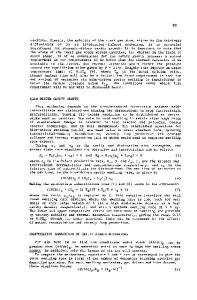Coherent Precipitate Formation in Pulsed-Laser and Thermally-Annealed, Ion-Implanted Si
- PDF / 2,084,410 Bytes
- 6 Pages / 417.6 x 639 pts Page_size
- 75 Downloads / 257 Views
B. R. APPLETON, J. NARAYAN, 0. W. HOLLAND AND S. J. PENNYCOOK Solid State Division, Oak Ridge National Laboratory, Oak Ridge,
TN 37830
ABSTRACT It will be shown that under suitable conditions ion implanted impurities in Si can precipitate and grow coherently within the single crystal lattice during recrystallization induced by pulsed laser or thermal annealing. Ion channeling and transmission electron microscopy (TEM) were used to characterize such precipitates in Si implanted with Sb and B and thermally annealed, and in Si implanted with Tl and annealed with a pulsed ruby laser. The orientations of these precipitates were determined from TEM and detailed angular scans using ion scattering channeling. The nucleation and precipitation processes will be discussed in terms of differences in the liquid and solid phase regrowth mechanisms.
INTRODUCTION Careful examination of the formation or dissolution of precipitates during thermal or laser annealing can provide important information on solute atom interactions, defect-solute interactions, metastable alloy formation, and crystal growth [1-7]. It is well established that supersaturated substitutional alloys can be formed in Si by ion implantation doping followed by thermal annealing [4], or pulsed laser annealing [5]. In the case of thermal (furnace or cw laser) annealing the near-surface region of the single crystal is turned amorphous by ion implantation and annealing in the range 450-6000C initiates solid phase epitaxial (SPE) regrowth. Solute concentrations in these "defect-free" regrown layers can exceed retrograde solubility limits by more 2 than a factor of 10 [4]. Trapping of the implanted impurities into substitutional sites in excess concentrations is possible because of the relatively rapid motion of the crystalline/amorphous interface compared to dopant diffusion in the solid state. If these SPE grown layers are subsequently heated solute concentrations in excess of equilibrium solubility at this temperature precipitate out [4]. In the case of pulsed laser annealing the near surface of Si melts, the dopant diffuses in the liquid, and during the rapid liquid phase epitaxial (LPE) regrowth of the surface the dopants can acquire substitutional sites by solute trapping at concentrations which greatly exceed equilibrium solid solubility limits [5]. If these samples are subsequently heated solute concentrations in excess of the solid solubility limits at that temperature can form precipitates. Provided the dopant is soluble in liquid Si, (i.e., such as B, P, As, Sb, Ga or In) precipitates can be redissolved into solution at the previous supersaturated concentrations by pulsed laser irradiation [6]. A notable exception is Bi which is immiscible in liquid silicon. In this case, provided the velocity of the liquid-solid interface is sufficiently slow and the concentration of Bi *Research sponsored by the Division of Materials Sciences, U. S. Department of Energy under contract W-7405-eng-26 with Union Carbide Corporation. Mat.
Res.
Soc.
Symp.
Proc.
Vol.
13
Data Loading...











